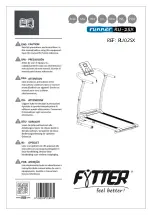
41
EN109-1665751-44
10.5 Exercise tests
This part of the user manual describes the implemented cardiorespiratory test protocols for the EN-Motion
treadmill. During the implementation of these tests, a great deal of attention has been paid to reliability, safety
and ease of use. In order for you to use your EN-Motion treadmill correctly and safely, it is important for you to
read the instructions in points 5.3 and 8.2 before use.
Exercise tests form an essential component of personalised training programmes. They contribute to the
proper evaluation of the training results, and good coordination between load and load capacity makes the
training more effective. This increases
the patient’s confidence in the therapy, as well as the motivation of the
user.
You can choose from one of the following tests:
1) Conconi test
2) Cooper test
3) 6-minute walking test (6MWT)
4) 2-km UKK walking test
5) Claudication test
10.5.1
Conconi test
The Conconi test is a simple way of measuring the heart rate and speed of the anaerobic threshold, as well as
the maximum heart rate and speed. This test usually takes the form of a running test, but other sports, such as
cycling, are also suitable. The speed and exertion levels are gradually increased during the Conconi test. The
heart rates are detected using a heart-rate meter. Based on the speed increase and the heart rates, the
relationship between these factors is determined.
The test begins at the speed which you have entered (see below). The initial speed is low. At the beginning of
the test, the heart rate increases in proportion to the increase in speed. Every 200 metres, the speed is
gradually increased by 0.5 km/h until the person is no longer able to maintain the required speed. According to
Conconi, an Italian professor, the anaerobic threshold is reached at the point at which this linear relationship
between the heart rate and the speed changes.
You can estimate the aerobic threshold on the basis of the anaerobic threshold. Research has shown that the
aerobic threshold is around 20 beats below the anaerobic threshold. You can continue with the test until the
maximum heart rate has been reached.
Performing the Conconi test
You must perform the test in an environment in which the speed can be increased in a controlled manner.
To ensure the reliability of the results, it is important to increase the speed by the same increment at each load
level. The EN-Motion treadmill is an excellent tool for keeping the speed at the right level. The progression of
the test must be planned with care: the initial speed, the increase in speed and the maintenance of the speed.
A good warm-up before the test is crucial; the warm-up must be the same for each test. Before you perform the
test, you must determine the starting speed of the test. Using your best 10-km time, the Conconi Test Pace
Calculator can determine the starting speed of the test. Before the test it is better not to smoke, eat a heavy
meal or carry out strenuous physical exertion. Do not use alcohol or stimulants before the test. Do not eat
anything during the 2 to 3 hours before the test. Wear suitable clothing and sturdy shoes. Warm up before the
test. The test starts at 115 BPM! Measure your heart rate. End the test when you have reached your maximum
heart rate or when you cannot continue any longer! Cool down after the test and stretch your muscles.
At the end of the test, the results screen will show the relevant measured values.
With the traditional method of determining the Conconi point, the heart rate and the load (running speed) are
compared after the completion of the test. The point at which the relationship between the heart rate and the
increase in load (exertion) ceases to be linear is then determined. From this point onwards, although the load
increases, the heart rate does not (in other words, the energy for the extra work is supplied anaerobically).
With the modified Conconi test as performed on the EN-Motion, the increase in heart rate is continuously
examined in relation to the increase in speed during the test (instead of afterwards). The heart rate is
measured every 40 metres and compared with the heart rate of 60 seconds previously (i.e. in a virtual window).
If the difference between these two values is less than 3 beats per minute, it is regarded as a potential Conconi
point. If three of these points are measured in succession, the first point is regarded as the definitive Conconi
point.
The advantage of the modified Conconi test is that a point is found during the test, rather than afterwards.














































